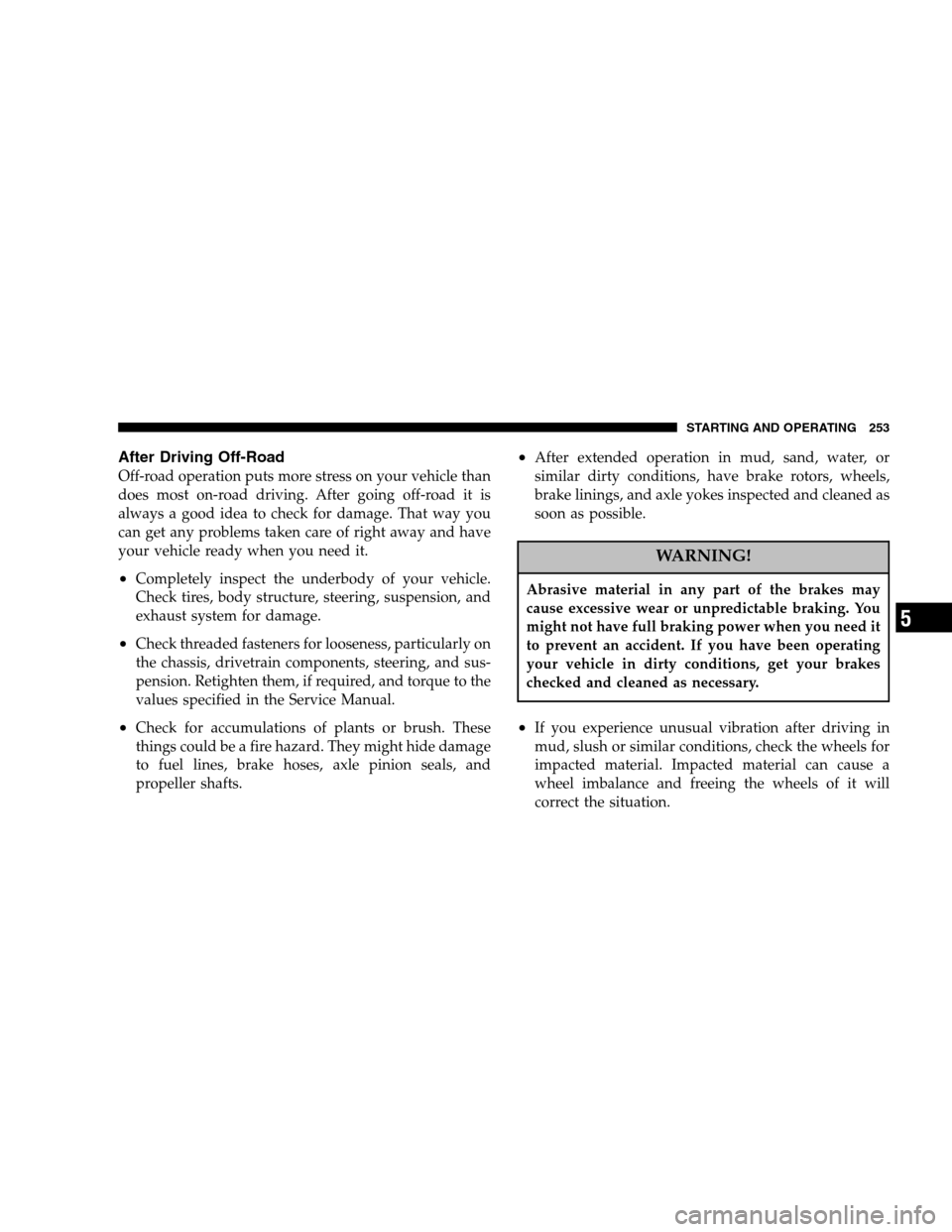Page 253 of 408

After Driving Off-Road
Off-road operation puts more stress on your vehicle than
does most on-road driving. After going off-road it is
always a good idea to check for damage. That way you
can get any problems taken care of right away and have
your vehicle ready when you need it.
•Completely inspect the underbody of your vehicle.
Check tires, body structure, steering, suspension, and
exhaust system for damage.
•Check threaded fasteners for looseness, particularly on
the chassis, drivetrain components, steering, and sus-
pension. Retighten them, if required, and torque to the
values specified in the Service Manual.
•Check for accumulations of plants or brush. These
things could be a fire hazard. They might hide damage
to fuel lines, brake hoses, axle pinion seals, and
propeller shafts.
•After extended operation in mud, sand, water, or
similar dirty conditions, have brake rotors, wheels,
brake linings, and axle yokes inspected and cleaned as
soon as possible.
WARNING!
Abrasive material in any part of the brakes may
cause excessive wear or unpredictable braking. You
might not have full braking power when you need it
to prevent an accident. If you have been operating
your vehicle in dirty conditions, get your brakes
checked and cleaned as necessary.
•If you experience unusual vibration after driving in
mud, slush or similar conditions, check the wheels for
impacted material. Impacted material can cause a
wheel imbalance and freeing the wheels of it will
correct the situation.
STARTING AND OPERATING 253
5
Page 295 of 408
WHAT TO DO IN EMERGENCIES
CONTENTS
�Hazard Warning Flashers.................296
�If Your Engine Overheats.................297
�Jacking And Tire Changing................298
▫Jack Location........................298
▫Spare Tire Stowage....................299
▫Spare Tire Removal....................299
▫Preparations For Jacking................300▫Jacking Instructions....................300
�Jump Starting Procedure..................303
�Emergency Tow Hooks — If Equipped........305
�Towing A Disabled Vehicle................306
▫2WD Models Only....................306
▫4WD Models Only....................306
6
Page 296 of 408
HAZARD WARNING FLASHERS
Your vehicle’s hazard warning flasher is an emergency
warning system. When you activate it, all front and rear
directional signals will flash intermittently. Use it when
your vehicle is disabled on or near the road. It warns
other drivers to steer clear of you and your vehicle. This
is an emergency warning system, not to be used when the
vehicle is in motion.
To activate the warning flasher, push down on the button
on top of the steering column until it latches. To turn the
warning flasher off, push down again to unlatch the
button.
NOTE:With extended use, the flasher may run down
your battery.
Hazard Warning Switch
296 WHAT TO DO IN EMERGENCIES
Page 300 of 408
Preparations For Jacking
Park the vehicle on a firm level surface, avoid ice or
slippery areas,set the parking brakeand place the gear
selector in P (Park). Turn OFF the ignition.
WARNING!
Do not attempt to change a tire on the side of the
vehicle close to moving traffic. Pull far enough off
the road to avoid being hit when operating the jack
or changing the wheel.
•Turn on the Hazard Warning Flasher.
•Block both the front and rear
of the wheel diagonally oppo-
site of the jacking position.
For example, if changing the
right front tire, block the left
rear wheel.
•Passengers should not remain in the vehicle when the
vehicle is being jacked.
Jacking Instructions
1. Remove the spare tire, jack, and tools from storage.
2. Loosen (but do not remove) the wheel lug nuts by
turning them to the left one turn while the wheel is still
on the ground.
300 WHAT TO DO IN EMERGENCIES
Page 344 of 408

If the belts need cleaning, use a mild soap solution or
lukewarm water. Do not remove the belts from the
vehicle to wash them.
Replace the belts if they appear frayed or worn or if the
buckles do not work properly.
Maintenance After Off-Pavement Driving
After extended operation in mud, sand or water, or
similar dirty conditions, have your brake discs, brake
linings, and axle joints inspected and cleaned as soon as
possible. This will prevent any abrasive material from
causing excessive wear or unpredictable braking action.
Following off-pavement usage, completely inspect the
underbody of your vehicle. Check tires, body structure,
steering, suspension and exhaust system for damage.
Check threaded fasteners for looseness, particularly on
the chassis, drivetrain components, steering and suspen-
sion. Retighten, if required, to torque values specified in
the Service Manual. Also check for accumulations ofvegetation or brush that could become a fire hazard, or
conceal damage to fuel lines, brake hoses, axle pinion
seals, and propeller shafts.
CAUTION!
Under frequent heavy-duty driving conditions,
change all lubricants and lubricate body compo-
nents, all driveline joints and steering linkage more
often than in normal service to prevent excessive
wear.
344 MAINTAINING YOUR VEHICLE
Page 350 of 408

VEHICLE STORAGE
If you are leaving your vehicle dormant for more than 21
days you may want to take steps to protect your battery.
You may:
•Remove fuse #27 in the Intelligent Power Module
labeled Ignition-Off Draw (IOD#1).
•Or, disconnect the negative cable from the battery.
•Anytime you store your vehicle, or keep it out of
service (i.e. vacation) for two weeks or more, run the
air conditioning system at idle for about five minutes
in the fresh air and high blower setting. This will
insure adequate system lubrication to minimize the
possibility of compressor damage when the system is
started again.
REPLACEMENT BULBS
Interior Lights Bulb Type
Glove Box Light......................... 194
Grab Handle Light................L002825W5W
Overhead Console Reading Lights..........VT4976
Rear Cargo Light.......................214–2
Visor Vanity Light.....................V26377
Underpanel Courtesy Lights................. 906
Instrument Cluster (General Illumination)....... 103
Telltale/Hazard Light...................... 74
* Available only from authorized dealers.
Exterior Lights Bulb Type
Backup Lights.........................3157A
Fog Lights.............................9145
Front Park Lights (Limited)...............194NA
Front Park Lights (Laredo)................194NA
Front Park/Turn Light (Limited)............3157A
350 MAINTAINING YOUR VEHICLE
Page 395 of 408

Data Recorder, Event...................... 51
Daytime Running Lights................... 115
Dealer Service.......................... 316
Defroster, Rear Window................... 214
Defroster, Windshield................65,215,222
Diagnostic System, Onboard................ 313
Dimmer Switch, Headlight................. 116
Dipsticks
Automatic Transmission................. 337
Oil (Engine).......................... 316
Power Steering........................ 326
Disabled Vehicle Towing................... 306
Disposal
Engine Oil........................... 320
Used Engine Fluids..................... 320
Door Locks............................. 15
Door Locks, Automatic.................... 17
Door Opener, Garage..................... 138
Doors................................. 15Drive Belts............................ 320
Driving............................... 249
Off-Pavement......................... 250
Off-Road............................ 250
Electric Remote Mirrors.................... 75
Electrical Outlet, Auxiliary................. 148
Electronic Speed Control................... 134
Electronic Stability Program................ 124
Electronic Throttle Control Warning Light...... 170
Electronic Vehicle Information Center.......168,171
Emergency, In Case of
Freeing Vehicle When Stuck............... 238
Hazard Warning Flasher................. 296
Jacking............................. 298
Jump Starting......................... 303
Tow Hooks.......................... 305
Emission Control System Maintenance......314,362
INDEX 395
10
Page 396 of 408

Engine
Air Cleaner.......................... 323
Block Heater......................... 232
Break-In Recommendations................ 63
Compartment......................... 311
Cooling............................. 329
Exhaust Gas Caution..................64,280
Fails to Start.......................... 231
Flooded, Starting...................... 231
Fuel Requirements..................277,357
Jump Starting......................... 303
Oil ..............................316,357
Oil Change Interval.................... 317
Oil Disposal.......................... 320
Oil Filter............................ 320
Oil Filter Disposal...................... 320
Oil Selection.......................... 357
Overheating.......................... 297
Starting............................. 230Temperature Gauge..................... 167
Engine Oil Viscosity...................... 319
Engine Oil Viscosity Chart................. 319
Enhanced Accident Response Feature.......... 50
Entry System, Illuminated.................. 15
Event Data Recorder...................... 51
Exhaust Gas Caution...................64,280
Exhaust System......................... 328
Exterior Finish Care...................... 341
Filters
Air Cleaner.......................... 323
Engine Fuel.......................... 323
Engine Oil........................... 320
Finish Care............................ 341
Flashers.............................. 296
Hazard Warning....................... 296
Turn Signal.....................164,353,355
Flipper Glass, Tailgate..................... 24
396 INDEX